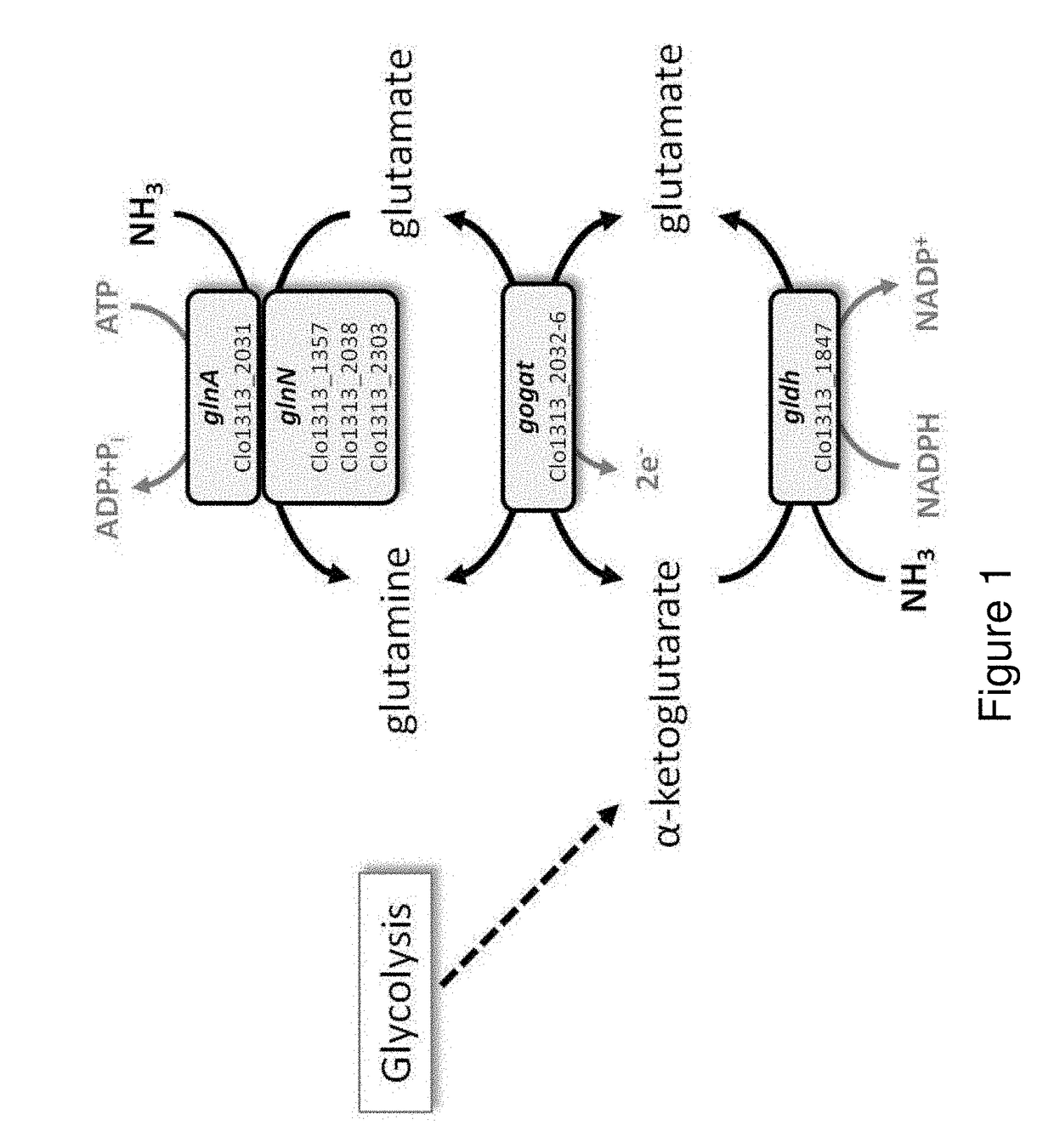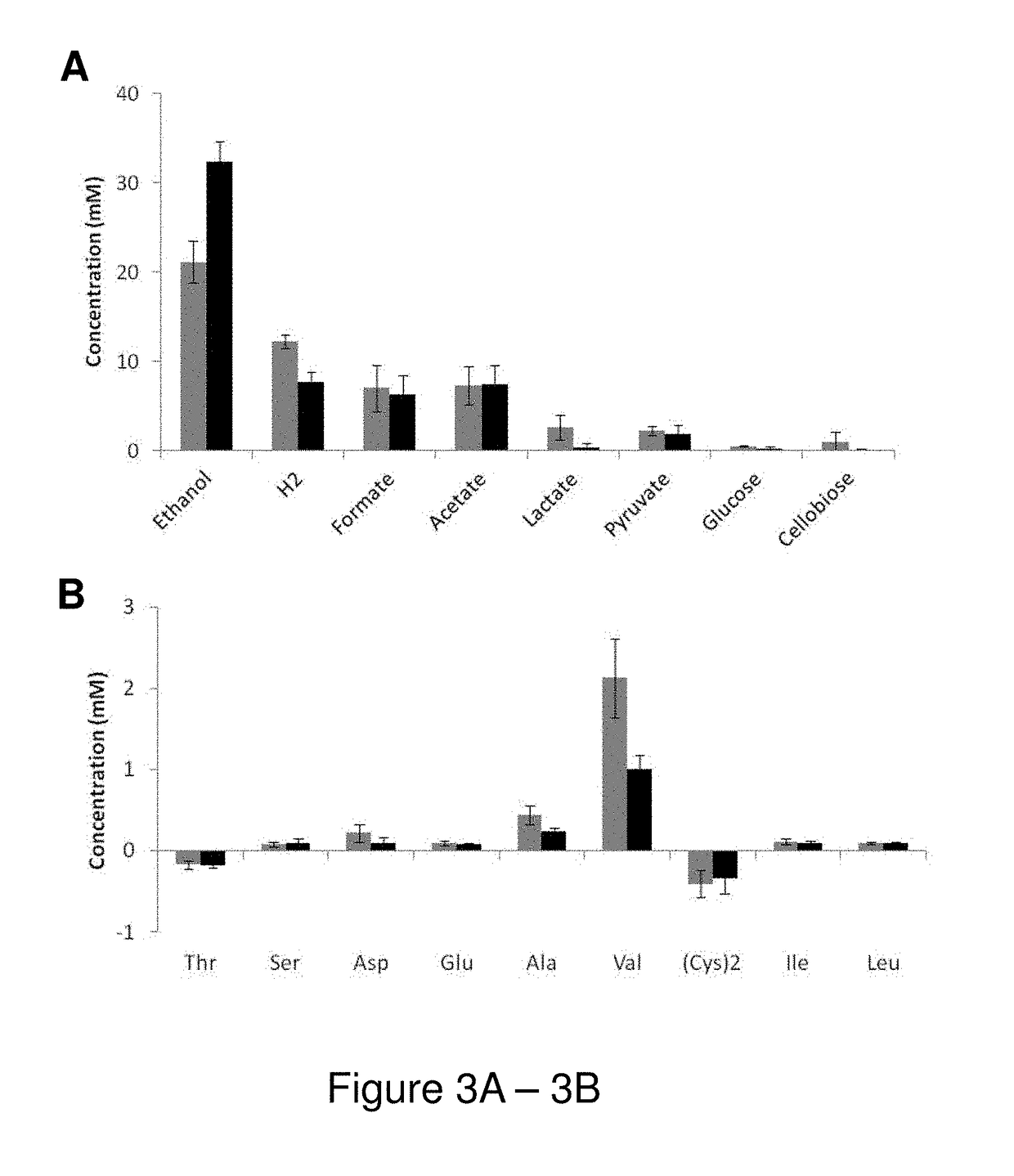Gene modification in clostridium for increased alcohol production
a technology of clostridium and clostridium sativum, which is applied in the field of gene modification in clostridium for increasing alcohol production, can solve the problems of increasing food costs, increasing the volatility of ethanol prices, and the inability to natively deconstruct lignocellulosic biomass to liberate fermentable sugars
- Summary
- Abstract
- Description
- Claims
- Application Information
AI Technical Summary
Benefits of technology
Problems solved by technology
Method used
Image
Examples
example 1
Materials and Methods
Plasmid and Strain Construction
[0081]All enzymes and reagents used for cloning were purchased from NEB (Ipswich, Mass.), unless otherwise specified. Escherichia coli Top10 (dam+ dcm+; Invitrogen, Carlsbad, Calif.) and BL21 (dam+ dcm−; New England Biolabs, Ipswitch, Mass.), used for plasmid construction and propagation, respectively, were grown aerobically on LB medium supplemented with 12 μg / ml chloramphenicol as required for plasmid maintenance. Plasmid isolation and purification was performed using QIAprep spin miniprep kits (QIAGEN, Germantown, Md.). Plasmid pNJ22::2031_del for deletion of glnA (Clo1313_2031) was constructed using Gibson Assembly according to the manufacture's using primers listed Tables 1-3.
TABLE 1Primers for pNJ22::2031_del construction via Gibson assemblyPrimer NameSequenceGib_2031_up_fwdATTTTGTTTCCCATAGGCGCGCCGATATTTTTAAATACTCAATCAAAACACATTTTGCTCTG (SEQ ID NO: 1)Gib_2031_up_NotI_revCACGCATAATTAGCCGAGAATATGGCCAGCGGCCGCTAAGATTTTCTAAGATAAGTC...
example 2
Genomic Analysis of Nitrogen Assimilation
[0096]The genome of C. thermocellum encodes one NADPH-dependent glutamate dehydrogenase (gldh; Clo1313_1847), one cluster of glutamine-oxoglutarate aminotransferase / glutamate synthase type enzymes (gogat; Clo1313_2032-2036), and four glutamine synthetases, including three Type III glutamine synthetases (glnN; Clo1313_1357, 2038, 2303), and one Type I glutamine synthetase (glnA; Clo1313_2031) (FIG. 1). Biocyc (Karp, 2005. Abstr Pap Am Chein S. 229, U1178-U1178; Romero and Karp, 2004, Bioinformatics. 20, 709-U342) and DOOR (Dam et al., 2007; Mao et al., 2009) predict Clo1313_2030-2036 to be a single operon, and the electron carrier is unknown. Organization of genes and predicted operons involved in nitrogen assimilation are provided in FIG. 6. In principle, any two of these three pathways (GLDH, GOGAT, and GS) should be sufficient to assimilate NH4, but the energetic cost differs depending on whether the ATP-hydrolyzing GS is utilized. Clo1313_...
example 3
Deletion of Type I Glutamine Synthetase Decreases Amino Acid Secretion and Increases Ethanol Production
[0097]The glnA gene, Clo1313_2031, encoding the sole Type I glutamine synthetase was deleted in C. thermocellum Δhpt, hereafter referred to as ΔglnA. The parent strain C. thermocellum Δhpt and ΔglnA were grown on 4.5 g / l (13.1 mM) cellobiose in defined medium (MTC5). Deletion of glnA had no impact on growth, as both Δhpt and ΔglnA strains grew to a final OD600 of ˜0.88 and had a mid-exponential phase generation time of 1.3 h(±0.1) (FIG. 2). Total elemental carbon in cell pellets for Δhpt and ΔglnA was 0.252(±0.010) and 0.269 g / l(±0.017), respectively (corresponding to 21.0 and 22.4 mM of carbon, respectively), and total pellet nitrogen was 0.062(±0.001) and 0.069 (0.002) g / l, respectively, further demonstrating that deletion of glnA had no significant impact on microbial biomass production. Interestingly, the initial pH of MTC5 (pH=7.43±0.06) decreased to only 6.64±0.13 in ΔglnA cu...
PUM
| Property | Measurement | Unit |
|---|---|---|
| temperature | aaaaa | aaaaa |
| octane/cetane number | aaaaa | aaaaa |
| volatility | aaaaa | aaaaa |
Abstract
Description
Claims
Application Information
 Login to View More
Login to View More - R&D
- Intellectual Property
- Life Sciences
- Materials
- Tech Scout
- Unparalleled Data Quality
- Higher Quality Content
- 60% Fewer Hallucinations
Browse by: Latest US Patents, China's latest patents, Technical Efficacy Thesaurus, Application Domain, Technology Topic, Popular Technical Reports.
© 2025 PatSnap. All rights reserved.Legal|Privacy policy|Modern Slavery Act Transparency Statement|Sitemap|About US| Contact US: help@patsnap.com



